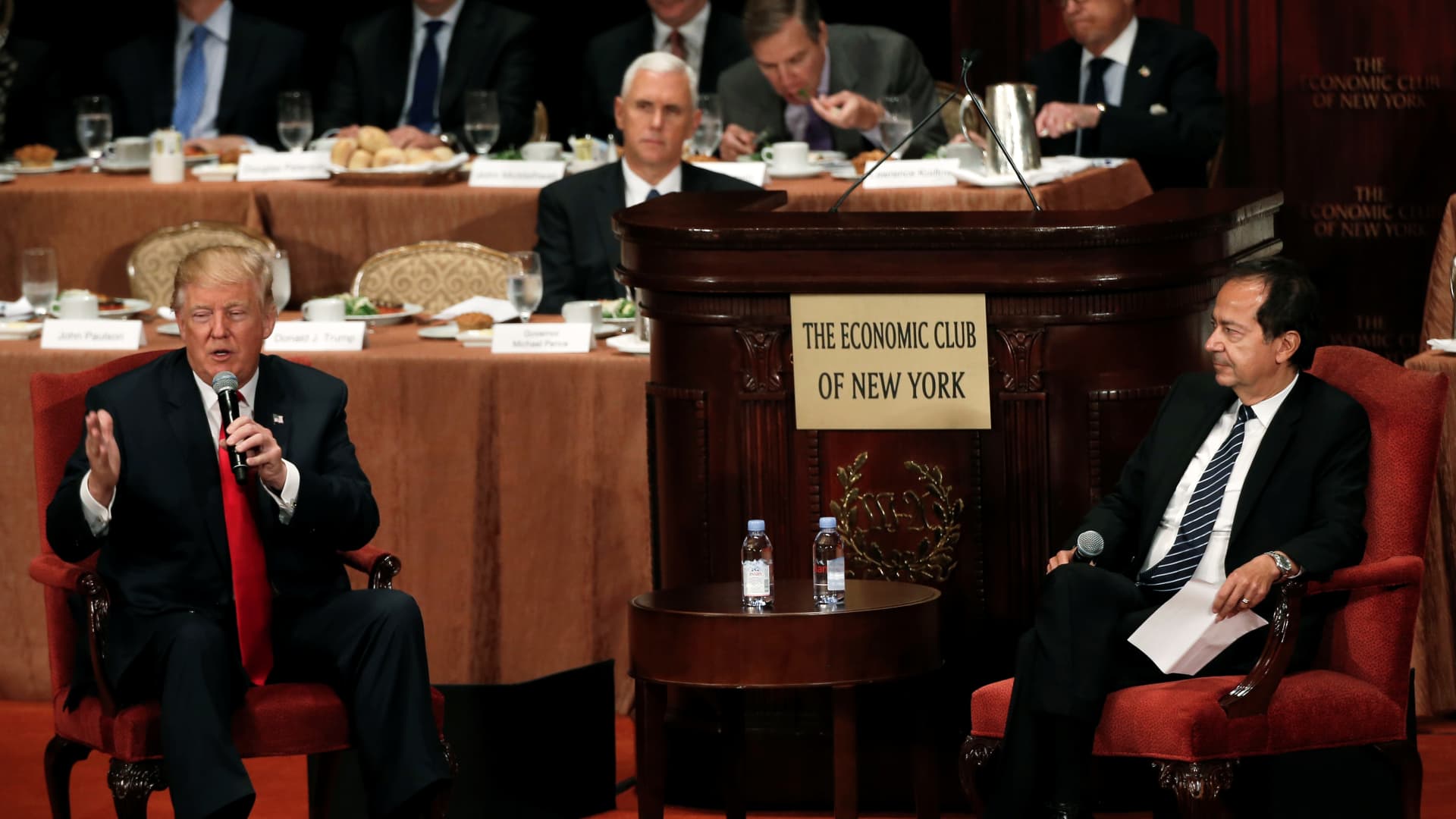Who Will Pay For Trump's Economic Policies?

Table of Contents
The Tax Cuts and Jobs Act of 2017: Winners and Losers
The Tax Cuts and Jobs Act of 2017 (TCJA) was a cornerstone of Trump's economic agenda. Its effects, however, were far from uniform, creating a clear divide between winners and losers.
Benefits for Corporations and the Wealthy
The TCJA drastically reduced the corporate tax rate from 35% to 21%, a significant boon for large corporations and their shareholders. High-income earners also saw substantial tax cuts.
- Significant reduction in corporate tax rates: This led to increased profits for many companies.
- Increased tax cuts for high-income earners and large corporations: The top 1% saw disproportionately large tax reductions.
- Impact on job creation: While the act aimed to stimulate job growth through increased corporate investment, the actual effect is debated. Many companies used their tax savings for stock buybacks instead of investing in new jobs or equipment.
- Examples of stock buybacks: Companies like Apple and other large corporations used a significant portion of their tax savings to increase shareholder value through stock buybacks, a strategy criticized for prioritizing short-term gains over long-term investment.
Specific Tax Cuts and Estimated Impact:
- Corporate Tax Rate: Reduced from 35% to 21%, estimated to cost the government trillions over a decade.
- Individual Tax Rates: Various reductions in individual tax brackets, with the largest benefits accruing to higher income earners.
Impact on the Middle Class and Low-Income Earners
The benefits of the TCJA were far less pronounced for the middle class and low-income earners. Many received only modest tax cuts, while some saw no change at all.
- Limited direct benefits: The tax cuts were structured to disproportionately benefit high-income individuals and corporations.
- Trickle-down economics debate: The effectiveness of "trickle-down economics," the theory that tax cuts for the wealthy would stimulate the economy and benefit everyone, remains a contentious issue. Empirical evidence supporting this theory is scarce.
- Increased national debt: The tax cuts, combined with increased government spending, contributed significantly to the national debt, potentially burdening future generations. This is a key aspect of the question, "Who will pay for Trump's economic policies?" - future taxpayers might be the ones footing the bill.
Comparison of Tax Benefits for Different Income Brackets: Studies show a vastly different impact of the tax cuts across income levels, with the wealthiest seeing the most significant tax reductions.
Increased Government Spending and its Funding
Trump's administration also saw increased government spending, raising questions about its funding sources and long-term sustainability.
Military Spending and Infrastructure Investments
Military spending increased significantly under Trump's presidency. While infrastructure investment was promised, the actual implementation fell short of expectations.
- Increased military spending: This had substantial economic implications, diverting resources from other sectors.
- Promised infrastructure investments: While significant investment was promised, the actual delivery lagged, leading to criticism of the administration's commitment.
- Effectiveness of spending on job creation: The economic impact of this increased spending on job creation and economic growth is a subject of ongoing debate and analysis.
Actual Spending vs. Promised Spending: A comparison of the budget allocations reveals a discrepancy between promised infrastructure spending and actual realized investment.
Funding Mechanisms: Increased Debt and Potential Cuts
The increased spending was largely financed through borrowing, leading to a substantial increase in the national debt.
- Increased national debt: The national debt grew significantly during Trump's presidency, raising concerns about long-term economic stability.
- Potential future tax increases or spending cuts: Addressing the increased national debt will likely require future tax increases or spending cuts, impacting future generations.
- Long-term economic consequences of increased national debt: The long-term economic consequences of this increased debt include higher interest rates, reduced economic growth, and potential financial instability.
National Debt Levels Before and After: A comparison of national debt figures clearly indicates a sharp increase during the Trump administration.
Trade Policies and Their Economic Consequences
Trump's administration pursued protectionist trade policies, leading to trade wars and renegotiation of existing trade agreements.
Tariffs and Trade Wars
The imposition of tariffs on various goods led to increased prices for consumers and businesses.
- Impact of tariffs on consumers and businesses: Tariffs increased prices for imported goods, impacting consumers and businesses relying on those goods.
- Effects of trade wars on specific industries: Certain industries benefited while others suffered significantly from the trade wars.
- Winners and losers in trade disputes: The winners and losers were largely determined by their exposure to international trade and the specific tariffs imposed.
Impact of Specific Tariffs on Various Goods: Detailed analysis reveals the varying impact of tariffs on different imported goods and the knock-on effects across the economy.
Renegotiation of Trade Agreements
The renegotiation of NAFTA, resulting in the USMCA, had significant impacts on various sectors.
- Analysis of the USMCA agreement: This agreement altered many aspects of the original NAFTA agreement, creating both winners and losers.
- Benefits and drawbacks for different groups: Some industries benefited while others faced challenges due to the changes in the trade agreement.
- Overall impact on the US economy: The long-term effects of these renegotiated trade agreements on the US economy are still being assessed.
Comparison of Old and New Trade Agreements: A comparison highlights the key changes in the agreements and their potential effects.
Conclusion
This article has explored the complex question of who bears the cost of Donald Trump's economic policies. While corporations and high-income earners directly benefited from significant tax cuts, the long-term consequences, including a ballooning national debt and the impact of trade disputes, remain a matter of ongoing debate. The ultimate distribution of costs across different segments of the population is still unfolding, and further research is needed to fully assess the long-term implications. Understanding these complex economic dynamics is crucial for informed discussion about future economic policy. Continue exploring this issue to learn more about who will pay for Trump's economic policies, and the lasting impacts of his administration's fiscal decisions.

Featured Posts
-
 Sag Aftra Joins Wga Complete Hollywood Shutdown
Apr 22, 2025
Sag Aftra Joins Wga Complete Hollywood Shutdown
Apr 22, 2025 -
 Ftc Appeals Microsoft Activision Merger Ruling
Apr 22, 2025
Ftc Appeals Microsoft Activision Merger Ruling
Apr 22, 2025 -
 Post Easter Truce Russias Renewed Assault On Ukraine
Apr 22, 2025
Post Easter Truce Russias Renewed Assault On Ukraine
Apr 22, 2025 -
 Ftcs Appeal Against Microsoft Activision Merger Approval
Apr 22, 2025
Ftcs Appeal Against Microsoft Activision Merger Approval
Apr 22, 2025 -
 Russias Easter Truce Ends Renewed Fighting In Ukraine
Apr 22, 2025
Russias Easter Truce Ends Renewed Fighting In Ukraine
Apr 22, 2025
